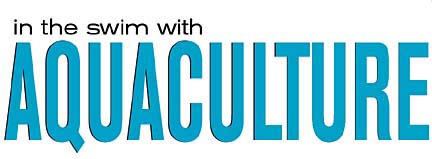
DENNIS ODA / DODA@STARBULLETIN.COM
Hawaii Aquaculture Association President Ron Weidenbach holds a variety of Hawaiian sunfish, more commonly known as tilapia, at his North Shore farm. A 200-foot-deep pond holds the pens for his tilapia, which swim near the surface, not the muddy bottom.
Global aquaculture conference
gives Hawaii's growing industry
a chance to show its stuff
Hawaii's aquaculture industry will get a boost next month when the World Aquaculture Society holds its triennial meeting at the Hawaii Convention Center.
The conference, to take place March 1 to 5, is expected to draw more than 4,000 delegates from around the world.
Hawaii has been the site of two previous conferences, in 1979 and 1988. Since that time, the local industry has matured tremendously, said John Corbin, who heads the state's Aquaculture Development Program.
The latest figures from the Department of Agriculture indicate the production value of aquaculture was just more than $25 million in 2002. Corbin said he expects 2003 figures to be even higher.
"My guess is that we're on track for about $27 million," he said. Compare those figures with 1978, when the commercial value of the industry was around $500,000, he said.
DENNIS ODA / DODA@STARBULLETIN.COM
Young tilapia in their rearing pens.
Corbin estimates there are now more than 100 aquaculture operations in Hawaii ranging from small, family run enterprises to high-tech national and international companies, some of which reside at the Big Island's National Energy Lab Hawaii Authority north of Kona.
Aquaculture is divided into four basic categories: Algae, such as ogo seaweed and spirulina; shellfish, such as marine shrimp, freshwater prawns, oysters and clams; finfish, such as tilapia, moi and catfish; and nonfood items, which include aquarium fish and plants, brood stock and seed stock.
The challenge for small local aquaculture farmers, like their dry-land counterparts, is to find a niche where they can be competitive, said Ron Weidenbach, president of the Hawaii Aquaculture Association.
Weidenbach, who raises golden tilapia at his farm in Waialua, said the primary market for his product is Chinatown.
In spite of any local stigma attached to the fish, tilapia has become a popular fish on the mainland and does well in blind taste tests held here at the annual Farm Fair.
DENNIS ODA / DODA@STARBULLETIN.COM
Ron Weidenbach and his wife, Lita, stand between some of their tilapia rearing pens. After they reach a certain size, the fish are transferred to cages in the nearby pond, where they grow to market size.
"Once you take the name and it's just taste and texture, it holds up against the best, he said.
"On the mainland, it's the fastest-growing commodity in U.S. agriculture. Last year, U.S. imports in tilapia topped $350 million," he said.
One of the most promising areas for Hawaii aquaculture is ornamental fish, both Weidenbach and Corbin said. With feed costs a big issue for any farmer, small ornamentals have minimal requirements, they said.
Moreover, Hawaii has good weather year-round. Even Florida, one of the biggest producers of ornamentals, has three to four cool months where production is low.
Hawaii has gradually developed a reputation for high quality, healthy ornamental fish; in contrast to South East Asian imports, where a significant portion of the fish are dead on arrival, Weidenbach said.
This year, part of the larger aquaculture conference will include a smaller Marine Ornamentals Conference.
That conference got its start on the Big Island back in 1999. With the collection of ornamentals in the wild becoming a big issue and countries closing borders to collection to protect what remains, the group will discuss issues related to collection, culture and conservation of marine ornamental fish.



